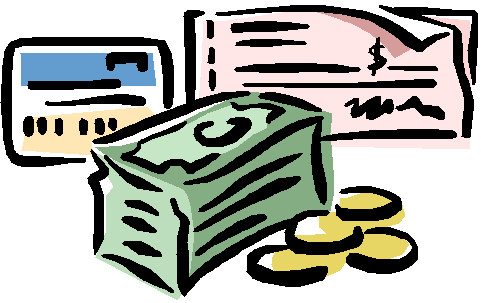
USING MONEY
I believe that students should know about the three ways they can pay for purchases: cash, checks, and cards.
TIPPING
A customer gives a tip to a server at a restaurant or a delivery person. That tip is usually between 15-20% of the cost of the meal/delivery, depending on how much money you have and how good the service is. Although people do have a calculator wherever they go (cell phones), calculating a tip in your head is not hard! It is also important to note that in other countries, the tip is already added on to the check of the meal.
Below is a trick to calculating a tip in your head. I have provided examples.
Calculating the standard 15% tip:
Take the total: $8.93
Move the decimal over one to the LEFT: 0.89
Take that number and add a HALF: 0.89 + 0.45 = $1.34
Calculating the really good service 20% tip:
Take the total: $34.22
Move the decimal over one to the LEFT: $3.42
Double it: $6.84
CHECKS
Checks are convenient when you don't want to carry around a lot of cash or when you need to pay bills through the mail.
To write a check: (From Money Basics)
1. Enter the date at the top of the check.
2. Write the name of the company or person you are paying money to in the "Pay to the Order of" line.
3. At the end of the "Pay to the Order of" line, write the number amount of the check (for example, $48.28).
4. On the dollars line, write the check amount in words. This confirms the number amount (for example, forty- eight dollars and 28/100). Note that you can write the cents as a fraction.
5. If there is blank space left after you write in the amount, draw a line out to the end—stopping before the word "dollars"—so no one can add to the amount*
(for example, forty-eight dollars and 28/100-----------------------dollars).
6. Write your signature on the line at the lower-right corner of your check.
7. In the "Memo" or "For" section in the bottom-left corner, write what the check is for (for example, "jeans for John" or "October rent").
* When writing the amount of money in words, you should draw a line before and after your words so that a random person doesn’t add the word “million” behind your words “fifty.”
Once all the information how much is it actually worth?
At the moment it is worth nothing!
So now what? Now you need to cash the check. In order to do this, you need to turn the check over, sign your name on the line at the top, and give it to the bank. This is called “endorsing a check.” Only the person receiving the check can officially endorse it.
Nowadays, checks could be considered old fashioned. With new technology, there are programs such as PayPal, Venmo and Apple Pay - but you do that with your phone. Even though times are changing, it is still important to know how to use checks.
It’s also important to remember that there are security issues with checks. Your check has your account number on it, so you should only give your checks to people you trust.
CREDIT VS DEBIT CARDS
PRO
Credit Card
1) Get the good or service now, but you pay interest to use the credit card company’s money
2) You have the option to pay off your entire balance at the end of the month and not pay any interest
3) Credit card companies have reward programs which give miles/points/cash/free stuff for using their credit cards
4) More protection from fraudulent transactions*
5) If you pay regularly, you will build a good credit history
6) Increased security through chip technology
Debit Card
1) Linked to your checking account and is limited to whatever money is in that account (therefore, you don’t overspend)
2) Available for minors
3) Inexpensive to use - no annual fees
4) Easier to get if you have bad or no credit if you have a checking account
1) Linked to your checking account and is limited to whatever money is in that account (therefore, you don’t overspend)
2) Available for minors
3) Inexpensive to use - no annual fees
4) Easier to get if you have bad or no credit if you have a checking account
CON
1) Interest rates are high (expensive!)
2) More responsibility - could take on debt
3) Limits are greater than what you have in the bank (easy to overspend)
4) Annual fees
5) Deposit may be required for minors
6) If you do not pay it off regularly, you will not build a good credit history
1) Can only purchase goods or services that cost up to the amount of money available in the bank
2) Pay “overdraft” fees if go over your limit - very expensive!
3) If stolen, there’s limited protection from fraudulent transactions*
4) Debit cards do not help you build a credit score
*An examples of a fraudulent transaction is when a credit card is stolen and used by someone who is not you.
The majority of middle and high school students do not have a credit or debit card, but it is a popular payment method, especially among adults and college-aged students! The main take-away from this portion is that you never want to get into "bad" debt. There is good debt that leads you to getting an asset, such as a loan for a car or a mortgage for a house. There’s also bad debt on casual spending, such as from buying shoes, sport equipment, or countless frappuccinos which does not give you anything in the long run.
